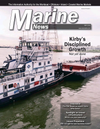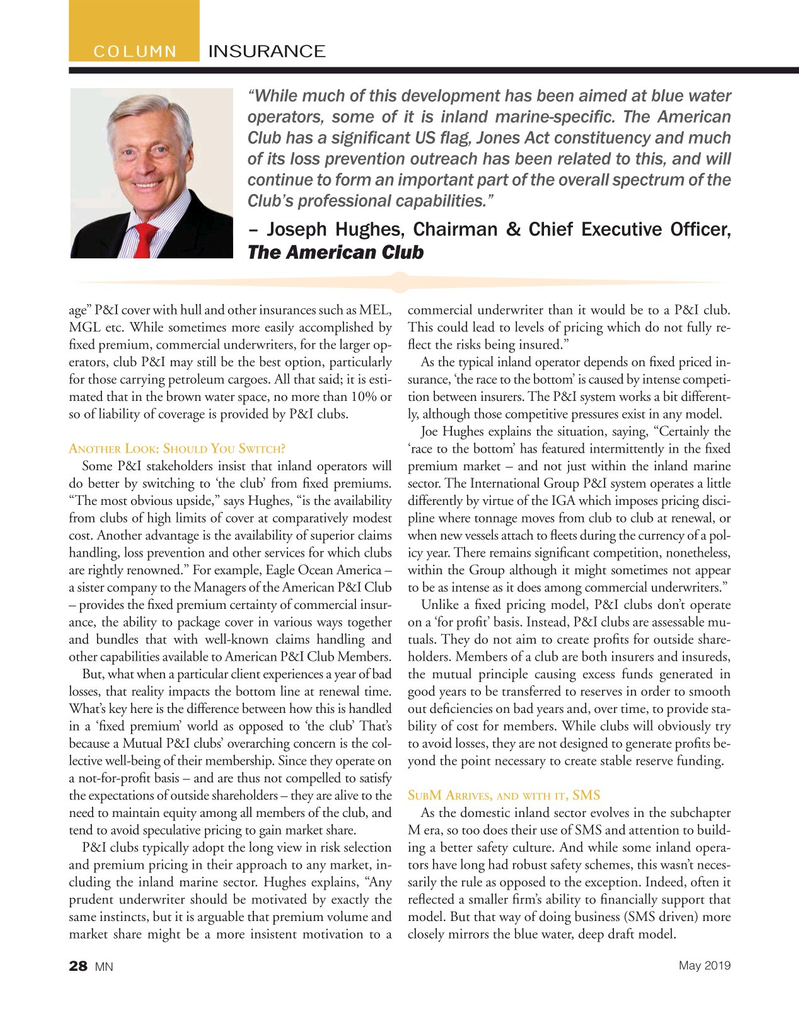
Page 28: of Marine News Magazine (May 2019)
Inland Waterways
Read this page in Pdf, Flash or Html5 edition of May 2019 Marine News Magazine
COLUMN INSURANCE “While much of this development has been aimed at blue water operators, some of it is inland marine-speci c. The American
Club has a signi cant US ag, Jones Act constituency and much of its loss prevention outreach has been related to this, and will continue to form an important part of the overall spectrum of the
Club’s professional capabilities.” – Joseph Hughes, Chairman & Chief Executive Of cer,
The American Club age” P&I cover with hull and other insurances such as MEL, commercial underwriter than it would be to a P&I club.
MGL etc. While sometimes more easily accomplished by This could lead to levels of pricing which do not fully re- ? xed premium, commercial underwriters, for the larger op- ? ect the risks being insured.” erators, club P&I may still be the best option, particularly As the typical inland operator depends on ? xed priced in- for those carrying petroleum cargoes. All that said; it is esti- surance, ‘the race to the bottom’ is caused by intense competi- mated that in the brown water space, no more than 10% or tion between insurers. The P&I system works a bit different- so of liability of coverage is provided by P&I clubs. ly, although those competitive pressures exist in any model.
Joe Hughes explains the situation, saying, “Certainly the
A L : S Y S ? ‘race to the bottom’ has featured intermittently in the ? xed
NOTHER OOK HOULD OU WITCH
Some P&I stakeholders insist that inland operators will premium market – and not just within the inland marine do better by switching to ‘the club’ from ? xed premiums. sector. The International Group P&I system operates a little “The most obvious upside,” says Hughes, “is the availability differently by virtue of the IGA which imposes pricing disci- from clubs of high limits of cover at comparatively modest pline where tonnage moves from club to club at renewal, or cost. Another advantage is the availability of superior claims when new vessels attach to ? eets during the currency of a pol- handling, loss prevention and other services for which clubs icy year. There remains signi? cant competition, nonetheless, are rightly renowned.” For example, Eagle Ocean America – within the Group although it might sometimes not appear a sister company to the Managers of the American P&I Club to be as intense as it does among commercial underwriters.” – provides the ? xed premium certainty of commercial insur- Unlike a ? xed pricing model, P&I clubs don’t operate ance, the ability to package cover in various ways together on a ‘for pro? t’ basis. Instead, P&I clubs are assessable mu- and bundles that with well-known claims handling and tuals. They do not aim to create pro? ts for outside share- other capabilities available to American P&I Club Members. holders. Members of a club are both insurers and insureds,
But, what when a particular client experiences a year of bad the mutual principle causing excess funds generated in losses, that reality impacts the bottom line at renewal time. good years to be transferred to reserves in order to smooth
What’s key here is the difference between how this is handled out de? ciencies on bad years and, over time, to provide sta- in a ‘? xed premium’ world as opposed to ‘the club’ That’s bility of cost for members. While clubs will obviously try because a Mutual P&I clubs’ overarching concern is the col- to avoid losses, they are not designed to generate pro? ts be- lective well-being of their membership. Since they operate on yond the point necessary to create stable reserve funding.
a not-for-pro? t basis – and are thus not compelled to satisfy the expectations of outside shareholders – they are alive to the S M A , , SMSUB RRIVES AND WITH IT need to maintain equity among all members of the club, and As the domestic inland sector evolves in the subchapter tend to avoid speculative pricing to gain market share. M era, so too does their use of SMS and attention to build-
P&I clubs typically adopt the long view in risk selection ing a better safety culture. And while some inland opera- and premium pricing in their approach to any market, in- tors have long had robust safety schemes, this wasn’t neces- cluding the inland marine sector. Hughes explains, “Any sarily the rule as opposed to the exception. Indeed, often it prudent underwriter should be motivated by exactly the re? ected a smaller ? rm’s ability to ? nancially support that same instincts, but it is arguable that premium volume and model. But that way of doing business (SMS driven) more market share might be a more insistent motivation to a closely mirrors the blue water, deep draft model.
May 2019 28 MN

 27
27

 29
29
